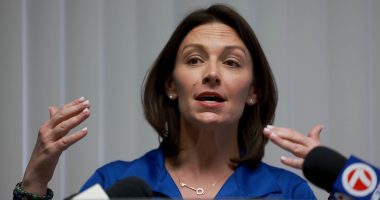
Around 37 million federal student-loan borrowers were spared $195 billion in loan payments since the government froze their payments at the onset of the pandemic, and many of them are likely to struggle with their debts when the moratorium is lifted, according to a report released Tuesday by the Federal Reserve Bank of New York.
Borrowers haven’t been required to make payments on so-called direct federal student loans, and interest rates on those loans have been set at zero, since Congress passed emergency legislation in March 2020, a pause that has since been extended through May 1 and could be extended further.
The bank found borrowers with a certain type of federal loan that is held privately, who didn’t have their payments frozen or had it frozen only briefly by their banks, had a 33% higher delinquency rate on their nonstudent, nonmortgage debt since late 2020 compared with the direct federal borrowers who remained in forbearance.
The authors said they expected federal borrowers who had their payments frozen to have similar trouble managing their debts when the freeze ends.
“We believe that Direct borrowers are likely to experience a meaningful rise in delinquencies, both for student loans and for other debt, once forbearance ends,” the New York Fed researchers wrote.
The analysis comes as the Biden administration considers its next steps for dealing with the roughly $1.6 trillion federal student-loan portfolio. The administration is under pressure from many congressional Democrats and supporters who want the freeze extended beyond May 1 for what would be the fourth time under President Biden, and the sixth time since it was adopted.
Many of those lawmakers, including Senate Majority Leader Chuck Schumer, of New York, and Massachusetts Sen. Elizabeth Warren, also want the administration to move forward with plans to cancel tens of thousands of dollars worth of debt per borrower, though Mr. Biden has been reluctant to pursue that policy in the belief that it would be more appropriate for Congress to settle the issue of debt cancellation.
Washington Sen. Patty Murray (D.), who leads the Senate’s education panel, has specifically pushed for a renewed pause into next year to give the administration time to come up with a plan to overhaul the student-loan payment system, including some debt forgiveness, especially for low-income borrowers, as well as changes to income-based repayment plans and altering how student debt affects consumer credit scores.
Top Republicans oppose another extension, and earlier this month two GOP representatives introduced a bill to prevent another pause, though it isn’t expected to gain traction in the Democratic-controlled House of Representatives.
There have been signs that the Education Department is preparing for a possible extension of the moratorium. Earlier in March, the Education Department told companies that service student loans on behalf of the federal government to hold off on telling borrowers that loan repayments would be restarting soon, according to people familiar with the matter, a message that was interpreted by many observers as a precursor to another extension. Politico first reported that the department did this.
“The department will continue communicating directly with borrowers about federal student-loan repayment by providing clear and timely updates,” an Education Department spokesperson said.
SHARE YOUR THOUGHTS
Should the freeze on student-loan payments be extended again? Why or why not? Join the conversation below.
Speaking on a podcast in early March, Mr. Biden’s chief of staff, Ron Klain, said the president would make a decision about using executive authority for debt forgiveness “before the pause expires, or he’ll extend the pause.”
More than 40 million people owe around $1.6 trillion in federal student debt, a sum bigger than credit-card or auto debt. Federal loans make up more than 90% of outstanding student debt. Borrowers with private loans aren’t eligible for the pause in payments, although some lenders and servicers have offered flexibility to borrowers who asked to suspend payments.
Jesse Wilburn, a 27-year-old electrical engineer in Philadelphia, said that while his $30,000 in student debt is relatively manageable, he is considering forgoing payments in solidarity with those who can’t pay back their loans if the freeze on payments ends in May.
“I try to be empathetic to the people whose lives are basically on pause until they can get this debt out from under them,” he said. Before the pandemic, he was paying around $300 a month to stay current on his loans.
The pause on student-loan payments has lasted longer than most other economic relief measures instituted in the early days of the pandemic by Congress and the White House, such as a ban on evictions and enhanced unemployment benefits, both of which expired last year.
Write to Gabriel T. Rubin at [email protected]
Copyright ©2022 Dow Jones & Company, Inc. All Rights Reserved. 87990cbe856818d5eddac44c7b1cdeb8









